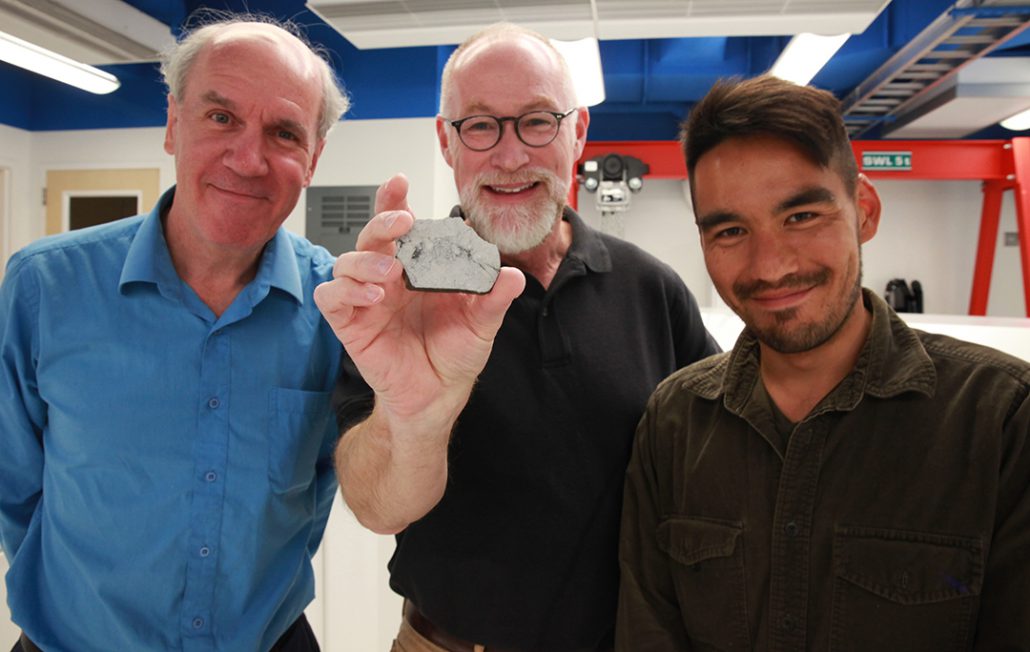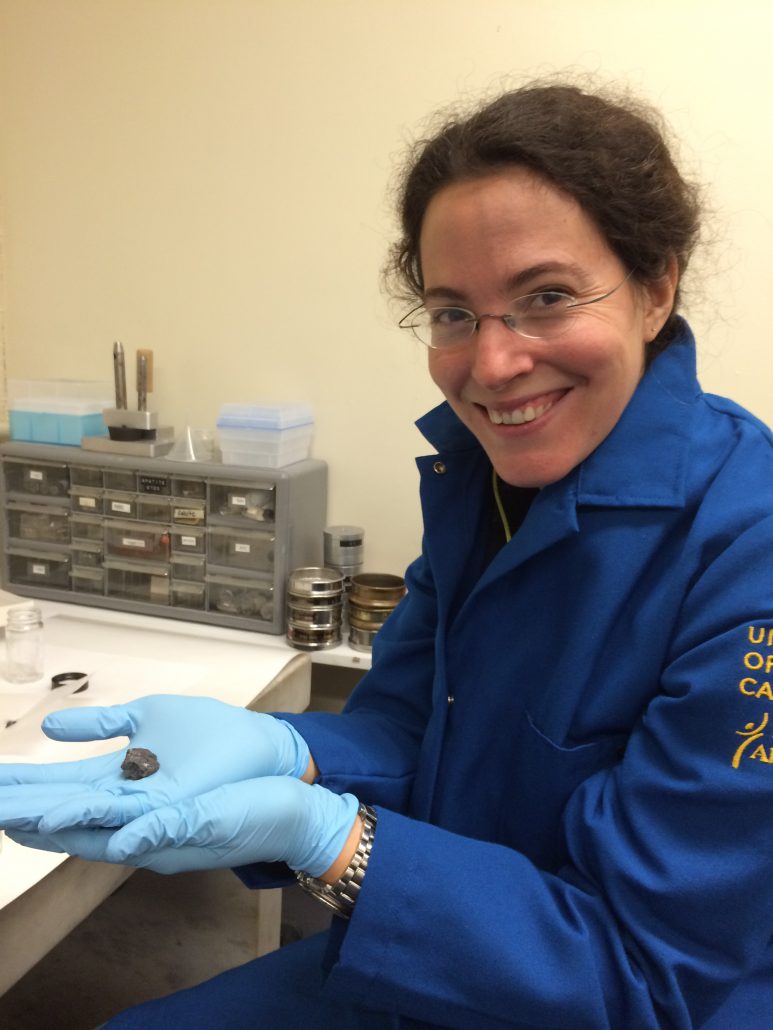VIOLENT, HEAD-ON COLLISION PRODUCED THE MOON
By Stuart Wolpert
The moon was formed from a violent, head-on collision between the early Earth and a “planetary embryo” called Theia approximately 100 million years after the Earth formed, almost 4.5 billion years ago, UCLA geochemists and colleagues reported in the journal Science.
Scientists knew about this high-speed crash, but many thought the Earth collided with Theia at an angle of approximately 45 degrees or more — a powerful sideswipe. New evidence substantially strengthens the case for a head-on assault.
The researchers analyzed seven rocks brought to the Earth from the moon by NASA missions Apollo 12, 15 and 17. They alsoanalyzed six volcanic rocks from the Earth’s mantle — five from Hawaii and one from Arizona.
How were they able to reconstruct the giant impact? The key to their detective work was a chemical signature revealed in oxygen atoms. (Rocks are 90 percent oxygen by volume, comprising half their weight.) Most oxygen atoms contain eight protons and eight neutrons and are represented by the symbol 16O. More than 99.9 percent of Earth’s oxygen is 16O, but heavier oxygen isotopes (variants) exist in trace amounts: 17O, with one extra neutron, and 18O, with two extra neutrons.
The Earth, Mars and other planetary bodies in our solar system each have a unique ratio of 17O to 16O — a distinctive fingerprint. A team of scientists from Germany reported last year in Science that the Earth and moon have different ratios of oxygen isotopes too.
The new research finds that is not the case.
“We don’t see any difference between the Earth and the moon’s oxygen isotopes; they’re indistinguishable,” said lead author Edward Young, professor of geochemistry and cosmochemistry.

Paul Warren, Edward Young and Issaku Kohl. Young is holding a sample of a rock from the moon.
Young’s research team used state-of-the-science technology and techniques to make extraordinarily precise and careful measurements, and verified them with UCLA’s new, larger mass spectrometer.
What does the absence of unique chemical signatures between the Earth and moon reveal? If the Earth and Theia had collided in a glancing side blow, the vast majority of the moon would have been made mainly of Theia, and the Earth and moon should have different oxygen isotopes, Young said. A head-on collision, however, likely would have produced a thorough mixing of the Earth and Theia — both in the Earth and the moon, he said.
“Theia was thoroughly mixed into both the Earth and the moon, and evenly dispersed between them,” Young said. “This explains why we don’t see a different signature of Theia in the moon versus the Earth. A glancing blow would not be consistent with this.”
Theia, which did not survive the collision (except as a large part of the Earth and moon) was growing and probably would have become a planet if the crash had not occurred, Young said. Theia was probably similar in size to the Earth, he believes.
The core of Theia and the core of the early Earth merged to form the Earth’s iron core, he said. The moon is approximately 100 times less massive than the Earth.
Co-authors of the Science paper are Issaku Kohl, a UCLA researcher in Young’s laboratory; Paul Warren, a UCLA researcher in the Department of Earth, Planetary, and Space Sciences; David Rubie, a research professor with Germany’s Bayerisches Geoinstitut, University of Bayreuth; and Seth Jacobson and Alessandro Morbidelli, planetary scientists with France’s Laboratoire Lagrange, Université de Nice.
The research was funded by NASA, the Deep Carbon Observatory and the European Research Council Advanced Grant ACCRETE.
The moon is older than scientists thought
Young is part of another UCLA-led research team that reported the moon is significantly older than some scientists believe. Their precise analysis of zircons bought to Earth by
Apollo 14 astronauts reveals the moon is at least 4.51 billion years old and probably formed only about 60 million years after the birth of the solar system — 40 to 140 million years earlier than recently thought.
Despite many scientific attempts, using a variety of techniques, the age of the moon has never been accurately determined and remains hotly debated among scientists.
“We have finally pinned down a minimum age for the moon; it’s time we knew its age and now we do: 4.51 billion years old,” said Mélanie Barboni, lead author and a research geochemist with the Department of Earth, Planetary, and Space Sciences.
“Whatever was there before the giant impact with Theia has been erased,” Barboni said. “It’s important to know when Earth started its evolution.”
The early Earth likely had many large colli-sions over its first 60 million years, Young said.
Barboni analyzed eight pristine zircons from two rocks and samples of soil brought to the Earth from the moon by the Apollo 14 mission. From most moon rocks, it is very difficult to determine their formation ages
because they contain a patchwork of fragments of multiple rocks.
“Zircons are nature’s best clocks,” said Kevin McKeegan, co-author and a professor of geochemistry and cosmochemistry in the Department of Earth, Planetary, and Space Sciences. “The most ancient pieces of the Earth that we have are zircons, which are the best mineral in preserving geological history and revealing where they originated.”
“Zircons are the best mineral at giving up their secrets,” Young said. “They can’t keep a secret.”
The researchers in effect used two clocks with high precision, the first time this has been achieved to date the age of the moon. In the zircons, they analyzed the chemical elements uranium-lead (uranium decays to lead) and lutetium-hafnium (lutetium decays to hafnium). This research was reported in the journal Science Advances.
The Earth’s collision with Theia created a liquefied moon, which then solidified. Scientists believe most of the moon’s surface was covered with magma right after its formation. The uranium-lead measurements reveal when the zircons first appeared in the moon’s initial magma ocean, which later cooled down and formed the moon’s mantle and crust; the lutetium-hafnium measurements reveal an earlier event: when its magma formed.
“Together, they tell us the whole story,” Barboni said. “The pieces now fit together.”
Earlier research on the moon has been based on moon rocks that were contaminated by multiple collisions. “They dated some event, but not the age of the moon,” McKeegan said of some previous researchers.

Mélanie Barboni holding a moon rock containing zircons.
Co-authors are Patrick Boehnke, a former UCLA graduate student in Professor Mark Harrison’s laboratory and now a University of Chicago postdoctoral scholar; Christopher Keller, a former Princeton University graduate student who is now a UC Berkeley postdoctoral scholar; Issaku Kohl, a research geochemist in Young’s laboratory; and Blair Schoene, associate professor of geosciences at Princeton University.
The research was funded by NASA, and Barboni received support from the Swiss National Science Foundation.
UCLA geochemists led by Harrison reported in 2015 that life likely existed on Earth at least 4.1 billion years ago, shortly after the planet formed — and that rather than being dry and desolate, the early Earth was probably much more like it is today than was previously thought.
Harrison’s research indicating the early Earth was wetter and cooler than scientists used to think fits much better with the 60-million-year date for the moon than a 200-million-year date would fit.



